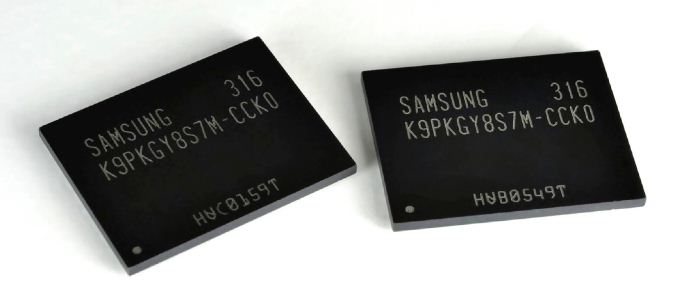Samsung Introduces The First eMMC 5.1 Based Flash Memory
by Brandon Chester on February 17, 2015 4:16 PM EST
Today Samsung revealed what they claim are the first flash memory chips based on the eMMC 5.1 standard which was just approved by JEDEC, the group that oversees the development of many semiconductor industry standards. eMMC is an embedded version of the MultiMediaCard standard that was once popular among digital cameras and PDAs. It allows for the NAND and controller in a device to be put into a small package on the logic board, which is a necessity when working with small mobile devices. Essentially every smartphone and tablet on the market today uses the eMMC standard as its storage solution.
As mobile devices have become more complex. there has been a need for improved NAND performance. Streaming and recording higher resolution content requires faster speeds for reading and writing, and so the evolution of the eMMC standard has been accompanied by improvements in performance at each step. When Samsung introduced their first eMMC 5.0 flash memory in 2013, their 64GB chips were rated for maximum sequential reads and writes of 250MB/s and 90MB/s respectively. Samsung's eMMC 5.1 memory increases the maximum write performance to 125MB/s. Similarly, random read performance increases from 7,000 IOPS to 11,000 IOPS and random write performance increases from 7,000 IOPS to 13,000 IOPS.
eMMC 5.1 based memory also has new features that will enable further improved performance. The feature that Samsung is specifically making note of is command queuing. True to its name, command queuing provides an interface for queuing up commands to be executed. This has been a feature of storage solutions in the PC world for some time, but previous eMMC controller implementations would submit commands and wait for completion before sending the next command.
Source: Samsung Semiconductor










42 Comments
View All Comments
frenchy_2001 - Wednesday, February 18, 2015 - link
Most year old flag ships phone can already record 4k video. My Galaxy note3 can already for example (not that I would use that, I'm usually recording 720p for storage/quality trade offs).Moreover, this is a bit of a non announcement. The only new thing is command queuing. Otherwise, eMMC 5.0 supported a 400MB/s interface. The current speed limitation is the NAND itself, as adding parallelism in a single package is difficult (NAND are rather slow, what makes SSD fast is multiple NAND channels).
SleepyFE - Wednesday, February 18, 2015 - link
http://www.gsmarena.com/samsung_galaxy_note_3-5665...It says here that you can take 4K pics but video is 2160p30 max. So 4K video is still a no go. Also flagships are not most phones, so most people won't be doing that.
You are right about multichannel controllers though. But since one channel flash is still faster than HDD my previous statement still stands. I WANT MORE RAM.
Azured - Wednesday, February 18, 2015 - link
2160p is 4kpsh99527 - Thursday, February 19, 2015 - link
There are too many people like you who pollute the internet with misleading information. 4K is 4096 x 2160, and no, there is no such thing as one channel flash. Why do you need more RAM? What device do you own? I'm assuming you'd need more megapixels on your phone and more screen resolution too?Uplink10 - Wednesday, February 18, 2015 - link
Phones already have so much RAM, they could run Windows 8.1, if the processor was x86.romesh - Wednesday, February 18, 2015 - link
Not so.. read about ufs 2.0, emmc lacks many standard feaures for hdd/ssd like command queuing and simultaneous read/writeextide - Thursday, February 19, 2015 - link
Not neccesarily. Sure, in random workloads, but small flash solutions like this tend to have fairly low sequential speeds, and a modern HDD is pretty dang fast at sequential, and all of the above workloads would imply sequential writes, of which this can only do 90MB/sec and this is the BEST eMMC you can get. Pretty much ANY HD from even a while ago will be able to do ~120-150+MB/sec in sequential writes..tipoo - Tuesday, February 17, 2015 - link
That makes little sense. Internal NAND performance is still tantamount to a good smartphone experience, from loading apps, moving around the OS, etc. USB 3 would be nice for file transfers from a computer, but the internal speed is still very important.SleepyFE - Tuesday, February 17, 2015 - link
The worst part is that the mini USB type B already exists but is not used. Unlike the micro USB type B its 3.0 version does not fit into a 2.0 socked and vice versa. But it is the same size as the 2.0 version which is also the size of a type C, it's just not reversible.danjw - Wednesday, February 18, 2015 - link
Samsung Galaxy S 5 has a USB 3.0 port. I am pretty sure there are others as well.Also, as others have stated with MIMO 802.11ac actually available on phones today, throughput on the storage of a device does matter.